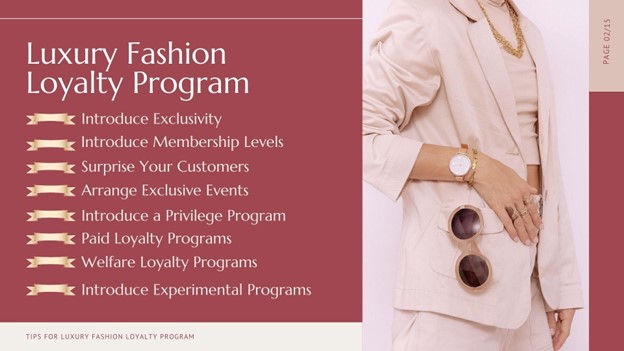A luxury fashion loyalty program is a customer acquisition and retention strategy. It involves hooking the customers to a long-term reward plan. The goal is to position it in a way that they need to keep making purchases to take advantage of the plan’s benefits.
These benefits are reasonable and deemed worth it mainly because luxury brands do not offer discounts. However, they do invite top spenders to exclusive events and parties they host. There are also instances that they invite this small portion of customers to their product launches and give freebies like small earrings or perfume.
But since the pandemic, social gatherings are limited. Thus, loyalty programs that only offer such benefits must adapt. Especially for a brand that competes in the fashion industry. You have to know how to entice your customers and keep them updated with your clothes and jewelry without them seeing it firsthand.
But how can you do that?
1. Introduce Exclusivity
Luxury fashion brands can be expressed in one single word–exclusivity. If your products cost a hundred times more than the average, you must offer exclusivity to your customers.
For example, release a rare watch or limited-edition real diamond earring that has only 20 copies in the world. You could also partner up with A-list personalities to create a limited-time collaboration.
This makes the items rare and would make their price relatively affordable considering how many copies you have. Doing this will make the product an investment since its scarcity will only make the price go up in the future.
You can offer the loyalty program to your customers through invitations to grab the limited edition products before everyone else. But you must be careful though. If you have a significant customer base, you might either need to cater to the top spenders or sacrifice exclusivity to include them all. This negates the point of being a luxury brand.
Although being a very top-down approach, this strategy has brought results to many brands.
2. Introduce Membership Levels
The age-old reward-per-purchase programs don’t work for luxury fashion brands as effectively as it does for average marketplaces. The luxury customers aren’t as driven for purchase rewards as others because of the low-frequency purchase cycle of the products.
Segregate Memberships into Tiers
People consider status and tiers in almost everything. Even in memberships, you could have tiers for people who wish to pay more for extra benefits.
- A tier two membership can offer products such as salon and spa coupons, cafe discounts, etc. This could be the top 10% of your customers.
- Tier One membership can offer discounts on jewelry for the top 5% of customers.
This tactic allows your luxury brand to build a bond with your valuable customers. They would also be eager to get promoted to a higher tier because of these benefits. Besides, no one loves freebies more than rich people.
3. Surprise Your Customers
Luxury fashion brands focus on building a relationship with each customer. They compensate for their lack of market share with their pricing. You, as a luxury fashion brand, need to cater to each customer and surprise them from time to time to keep them in the loop.
Surprising your customers may include insider access to exclusive information, personalized offers, earring studs as freebies, and even free shipping. Invitations to exclusive events may also be included in your surprise loyalty programs.
Mercedes Benz screams luxury and fashion in every way despite not being a fashion brand. They jumped on the “Surprise and Delight” wagon by interacting with existing and potential customers through social media.
They leveraged the hundreds of messages received every day on their Facebook and Instagram accounts. By introducing #MBSecretSanta, the company directly interacted with its customers to give away 1000 gifts ranging from branded teddies to Bluetooth speakers.
You can do the same for your luxury fashion brand. Give out jewelry, clothing, and even a real diamond stud for a lucky winner.
4. Arrange Exclusive Events
Brands with a huge customer base can’t usually arrange exclusive events. Imagine Amazon inviting millions of people to attend a dinner. Even if they do, their cost-to-profit ratio might not support the efforts.
Luxury fashion brands don’t have that issue. They can invite only a few hundred of your customers and be done with it. Moreover, if your brand doesn’t have a significant customer base, arranging exclusive events is much easier.
Hugo Boss has been associated with luxury fashion for decades. They specialize in men’s and women’s wear, accessories, and fragrances. In addition to introducing free-to-join membership tiers, they offer their loyal customers exclusive VIP events.
To arrange a successful event, you don’t necessarily need to spend a fortune. As a scaling luxury brand, in these events, your focus should be on offering exclusivity, promoting your products such as diamond jewelry, and not top-end features.
Suppose you are a brand that specializes in limited edition sneakers. You don’t necessarily need to bring athletes to your event. At the least, you can arrange a cybersecurity boot camp for loyal customers to let them know about the risks involved with using sneaker bots.
5. Introduce a Privilege Program
Brands often rent resorts, clubs, and restaurants for their loyal customers to enjoy at a discounted price. The customers can stay at the branded establishments at a cost that exceeds their expectations. The practice is often tied up with membership tiers to encourage customers to make more purchases.
With a privilege loyalty program, your customers will try to buy more from you just to keep their privilege program active and avail the best facilities in town without paying a hefty price. Your competitors might offer the same brand value at a similar price, but your customers will keep on coming back to make sure their account stays active.
An additional benefit of introducing a privilege program is that you don’t need to occupy the resorts or clubs throughout the year. If a customer wishes to avail of the benefit, you can process the request to make room for them.
6. Paid Loyalty Programs
In a paid loyalty program, your customers pay a monthly on yearly subscription fee to avail of the benefits associated with it. Most brands — luxury or not — are introducing paid loyalty fees on their platforms to prevent users from pivoting to their competitors.
As the customers are directly being asked to pay an additional fee over the price of your product, the features of the program need to be monetarily valuable. Free shipping, loyalty discounts, and exclusive invitations are generally considered in paid loyalty programs. But you can introduce different features at your convenience to satisfy the customers.
7. Welfare Loyalty Programs
As a society, we thrive on helping others and human welfare drives us more than anything. Rolex is a prominent example of it. The brand is owned by Hans Wilsdorf Foundation, which offers scholarships to students in Europe. Most of the profit that the watch brand makes is invested to secure the futures of students.
Your brand can also make use of something like that. Moreover, if you are just starting out and do not have the cash to spare, you can fund a significant amount yourself and ask your customers to add their bit to it. Following that path, you directly promote your actions and involve the audience to purchase more.
8. Introduce Experimental Programs
After Gucci was accused of racism and colonial nostalgia, they took the #Changemaker program in 2019 which tries to clear their name out of the accusations and present them in a new non-binary and inclusive light.
In this program, they appointed unconventional models and actors for their promotion, in addition to launching a new collection of wearables that can be worn by both men and women.
Although these efforts have made a significant impact to boost Gucci’s brand image, these were all experimental. They experimented with their loyal customer base to make themselves more inclusive to all ethnicities–boosting their sales.
The Bottom Line
A luxury brand can give back to its valued customers while ensuring that they would remain faithful to the brand. Exclusivity, surprises, and welfare are the fundamentals of developing customer loyalty programs.
But, don’t forget to consider events, early access, invitations, and experiential programs when brainstorming for the best luxury fashion loyalty program. You could also give out high-end freebies like diamond stud earrings and watches.
Choose which option works best for your customers and your brand!
Recommended Read: Luxury Retail: Creating the Year-Round Cyber Monday of Fine Jewelry





